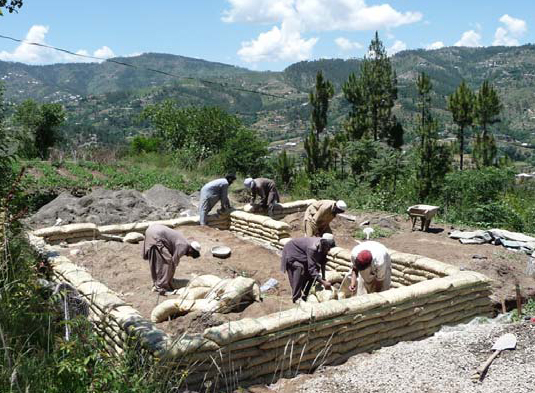
As you may well know, the recent floods in Pakistan destroyed or damaged 2 million homes, affecting 20 million people. PAKSBAB, an NGO building strawbale houses in Pakistan, uses gravel-filled earthbag foundations to protect their houses from water damage. To date, 22 houses have been built.
In addition to providing flood protection, PAKSBAB uses earthbag foundations because they are earthquake resistant. A shake table test at the University of Nevada, Reno, simulated the devastating Northridge (Canoga Park) quake that occurred in California. According to their report, “the house survived 0.82g, twice the acceleration of the Canoga Park record. Although severely damaged, the building did not appear in danger of collapse, even at the end of the test sequence.”

I live in Queensland, Australia with flooding in my area 3 times in the last 11 months. I live in a single storey (ordinary) house. Is it possible to add a second storey to it by using gravel bags – how high can you use gravel bags e.g. 8-10 ft then add earthbags? Council will consider alterate building as long as foundations are concrete and has an engineering assessment. Can I contact you about drawing up plans please? I can’t think of what elese we can do.
Gravel bags would work with rebar reinforcement on both sides. Tie together through the wall with baling twine and plaster both sides. But the problem is codes. You’ll see numerous blog posts here on our blog about building codes and how they skyrocket the cost of construction. (See today’s blog post, for example: https://naturalbuildingblog.siterubix.com/early-us-building-codes/)
Codes require adding concrete to the gravel, paying for an engineered approved design, etc. that the cost would be as much as regular concrete walls. It’s a legal scam as I’ve said over and over. The concrete, steel and brick industries wrote the codes to favor themselves and stifle competition. The solution is to move to areas with few or no codes and don’t contribute to the problem if possible.
If you’re still interested, contact Structure1.com. Not sure if they can do projects in Queensland.
Can anyone confirm if the “gravel bag foundation” included 1) a rubble trench 2) Rebar or bamboo support 3) A stabilizer like cement 4) If no stabilizer then can anyone predict how waterproof it would be?
It all depends on the details. How much flooding do you expect? It’s best to plan for a 100 year record flood. Are you on high ground? Is the ground sloping away from the building in all directions? Do you expect fast moving water that could topple walls? Extreme cases call for raising the building site or building on piers.
This is great news! We’re left to wonder, How would a full sized EB Home perform? One day, we shall see some great testing done, and verify our hands on experience!
Yeah, this is some of the best news ever. Hard to beat an actual shake table test at a U.S. government approved lab.
It’s hard to predict how an entire earthbag structure will hold up due to lack of testing, and because there are many ways to build with bags and many ways to reinforce them.
Due to their excellent track record of getting things done and their top quality design, I rate PAKSBAB as one of the best housing NGOs.